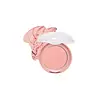What's inside
What's inside
 Key Ingredients
Key Ingredients

 Benefits
Benefits

 Concerns
Concerns

 Ingredients Side-by-side
Ingredients Side-by-side

Talc
AbrasiveMica
Cosmetic ColorantSilica
AbrasiveDiisostearyl Malate
EmollientHydrogenated Poly(C6-14 Olefin)
EmollientTriethoxycaprylylsilane
Dipentaerythrityl Hexahydroxystearate/Hexastearate/Hexarosinate
Skin ConditioningMagnesium Myristate
Octyldodecyl Stearoyl Stearate
EmollientHdi/Trimethylol Hexyllactone Crosspolymer
CI 73360
Cosmetic ColorantCI 19140
Cosmetic ColorantCI 77742
Cosmetic Colorant1,2-Hexanediol
Skin ConditioningCI 77891
Cosmetic ColorantGlyceryl Caprylate
EmollientHydrogenated Lecithin
EmulsifyingCI 77499
Cosmetic ColorantCI 77491
Cosmetic ColorantAluminum Hydroxide
EmollientDimethicone
EmollientMethicone
EmollientTalc, Mica, Silica, Diisostearyl Malate, Hydrogenated Poly(C6-14 Olefin), Triethoxycaprylylsilane, Dipentaerythrityl Hexahydroxystearate/Hexastearate/Hexarosinate, Magnesium Myristate, Octyldodecyl Stearoyl Stearate, Hdi/Trimethylol Hexyllactone Crosspolymer, CI 73360, CI 19140, CI 77742, 1,2-Hexanediol, CI 77891, Glyceryl Caprylate, Hydrogenated Lecithin, CI 77499, CI 77491, Aluminum Hydroxide, Dimethicone, Methicone
Talc
AbrasiveMica
Cosmetic ColorantSilica
AbrasiveBoron Nitride
AbsorbentHexyl Laurate
EmollientDimethicone
EmollientCaprylic/Capric Triglyceride
MaskingDiphenylsiloxy Phenyl Trimethicone
Skin ConditioningMagnesium Myristate
Methylpropanediol
SolventCI 77220
Cosmetic ColorantDipentaerythrityl Hexahydroxystearate/Hexastearate/Hexarosinate
Skin ConditioningPropanediol
SolventTriethoxycaprylylsilane
Methicone
EmollientWater
Skin ConditioningCI 15985
Cosmetic ColorantCI 77491
Cosmetic ColorantCI 19140
Cosmetic ColorantCI 73360
Cosmetic ColorantCI 77007
Cosmetic ColorantCI 77499
Cosmetic ColorantTalc, Mica, Silica, Boron Nitride, Hexyl Laurate, Dimethicone, Caprylic/Capric Triglyceride, Diphenylsiloxy Phenyl Trimethicone, Magnesium Myristate, Methylpropanediol, CI 77220, Dipentaerythrityl Hexahydroxystearate/Hexastearate/Hexarosinate, Propanediol, Triethoxycaprylylsilane, Methicone, Water, CI 15985, CI 77491, CI 19140, CI 73360, CI 77007, CI 77499
 Reviews
Reviews

Ingredients Explained
These ingredients are found in both products.
Ingredients higher up in an ingredient list are typically present in a larger amount.
CI 19140 is also known as Tartrazine. Tartrazine is a synthetic dye used in cosmetics, foods, and medicine to add a yellow color.
Tartrazine is created from petroleum and is water-soluble.
Some people may experience allergies from this dye, especially asthmatics and those with an aspirin intolerance.
Learn more about CI 19140Ci 73360 is a synthetic red-pink dye.
Ci 77491 is also hydrated iron III oxide. It's sole purpose is to give a red/pink hue to products.
Iron III oxides are classified as inorganic chemicals for coloring.
Synthetically created Ci 77491 is considered safer than those naturally found. This is because the synthetically created version may contain less impurities. Iron oxides are generally non-toxic and non-allergenic.
Learn more about CI 77491Ci 77499 is also hydrated iron III oxide. It is created from mixing red and black iron oxides. This helps give shades of darkness to a product.
Iron III oxides are classified as inorganic chemicals for coloring.
Dimethicone is a type of synthetic silicone created from natural materials such as quartz.
What it does:
Dimethicone comes in different viscosities:
Depending on the viscosity, dimethicone has different properties.
Ingredients lists don't always show which type is used, so we recommend reaching out to the brand if you have questions about the viscosity.
This ingredient is unlikely to cause irritation because it does not get absorbed into skin. However, people with silicone allergies should be careful about using this ingredient.
Note: Dimethicone may contribute to pilling. This is because it is not oil or water soluble, so pilling may occur when layered with products. When mixed with heavy oils in a formula, the outcome is also quite greasy.
Learn more about DimethiconeWe don't have a description for Dipentaerythrityl Hexahydroxystearate/Hexastearate/Hexarosinate yet.
We don't have a description for Magnesium Myristate yet.
Methicone is a type of silicone and is a simpler form of dimethicone.
Silicones are used to enhance the texture of products and have emollient properties. Methicone is used to give products a silky texture and improves spreadability.
Mica is a naturally occurring mineral used to add shimmer and color in cosmetics. It can also help improve the texture of a product or give it an opaque, white/silver color.
Serecite is the name for very fine but ragged grains of mica.
This ingredient is often coated with metal oxides like titanium dioxide. Trace amounts of heavy metals may be found in mica, but these metals are not harmful in our personal products.
Mica has been used since prehistoric times throughout the world. Ancient Egyptian, Indian, Greek, Roman, Aztec, and Chinese civilizations have used mica.
Learn more about MicaSilica, also known as silicon dioxide, is a naturally occurring mineral. It is used as a fine, spherical, and porous powder in cosmetics.
Though it has exfoliant properties, the function of silica varies depending on the product.
The unique structure of silica enhances the spreadability and adds smoothness, making it a great texture enhancer.
It is also used as an active carrier, emulsifier, and mattifier due to its ability to absorb excess oil.
In some products, tiny microneedles called spicules are made from silica or hydrolyzed sponge. When you rub them in, they lightly polish away dead skin layers and enhance the penetration of active ingredients.
Learn more about SilicaTalc is a clay mineral. It helps absorb moisture and improve the texture of products. Like other types of clay, Talc can have a slight exfoliating effect on skin. Talc can be added to increase the volume of products.
Some Baby powders are made by combining talc with corn starch. The word "talc" comes from Latin and originates from Arabic. Talc is a mineral commonly found throughout the world.
If you have any concerns about using talc, we recommend checking out the FDA's official page.
Learn more about TalcTriethoxycaprylylsilane is a silicone used to bind and stabilize ingredients.
As an emulsifier, it helps prevent ingredients from separating. This can help elongate the shelf life of products.
Triethoxycaprylylsilane is often used to coat mineral sunscreens ingredients to help give a better feel. It also helps reduce oxidative stress in sunscreens.
Learn more about Triethoxycaprylylsilane